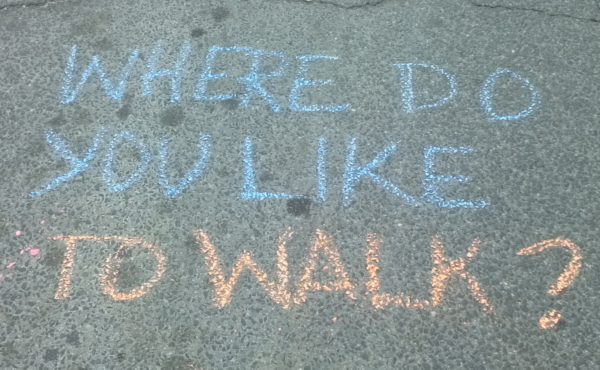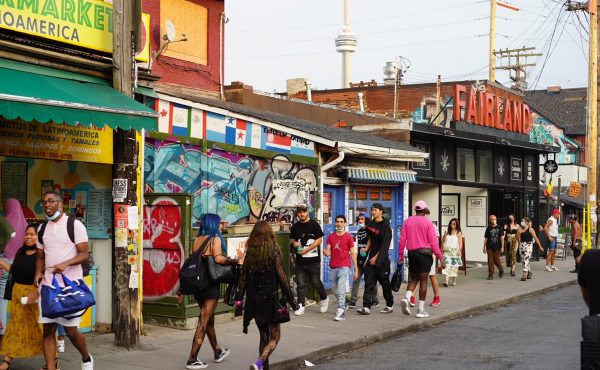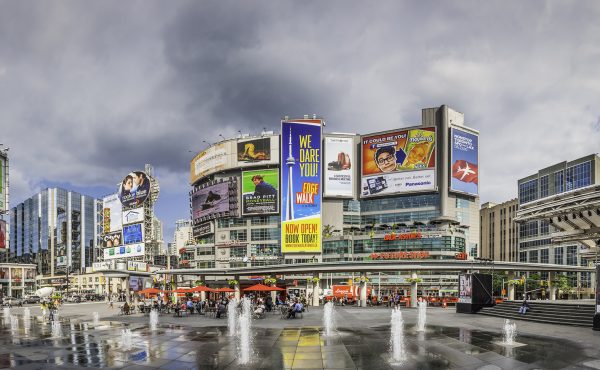![]()
Spacing teamed up with the highly-regarded photoblogger Sam Javanrouh to create a fun time-lapse of the new Yonge-Dundas pedestrian scramble (see below). We’ve written a handful of posts on it over the last few days, so there’s no need to elaborate much more.
Check out the HD version on Vimeo.
Scramble from Sam Javanrouh on Vimeo.




31 comments
It should be noted that there was a looming rain storm when we shot this, thus the human traffic is a little light.
I thought that the idea of a scramble intersection was that pedestrians could only cross during the “scramble” time so that turning vehicles wouldn’t run into pedestrians crossing with traffic.
But this looks like there are regular pedestrian crossings while traffic is moving and then an additional one where they can cross diagonally.
Doesn’t that sort of defeat the purpose of the scramble?
That video’s greatâ€â€I love the rhythm of it. Brilliant stuff.
Have to say the amount of froth on the internet over one traffic signal is pretty amazing… *rolls eyes*
@jay — FYI, this intersection does not allow automobiles to turn left or right, so why not allow pedestrians to cross?
I love how the images flow so smoothly. I wonder what interval Sam took these? This makes me want to experiment myself…
Nice!
When you said Sam Javanrouh, I thought it would be a tilt-shift of the intersection but this is much cooler.
You guys should do it again on Saturday or Sunday when the intersection is overflowing with people.
Jay – I thought the same thing… ordinarily you don’t let peds cross so turning traffic is more efficient, but there are no turns in any direction at that intersection…
The scramble is really only useful for the people who get there at just the right time in this case
The scramble is a tourist attraction. That’s about it. This doesn’t make it any less useful, but there’s no denying that it was placed there first for the tourist traffic.
The original first location was to be Bloor/Yonge, but that intersection is in the middle of major construction for quite a while and is therefore not a good place for the trial.
Dundas/Yonge is a big public corner.
What I found interesting is that I didn’t see horrendous backlogs of traffic in the two visible directions despite the longer cycle times.
There is also a subtle thing going on with the westbound carstop: Because cars can pick up before they get to the intersection, they don’t have to be right at the top of the queue to serve the stop.
@DH > Tourists? What about Ryerson students moving from one building to another (Bay and Dundas), or Eaton Centre Shoppers. Lots of locals pass through here. I do usually everyday.
Great work Sam, thats why you remain my overlord.
Check out at about the 1:00 mark, the cab that first advances over the crosswalk, then at the scramble phase, parks himself right in the middle of the intersection… priceless.
Both the photo and video are fantastic!! Glad to see this type of crossing finally in place and in use. Looks like folks are having no trouble at all figuring it out – like ducks to water 😉
Was in Calgary, a young lad at the time in the 1950s and they had a scramble which I think was short-lived.
Seen all over the world of course…big deal here. I chuckled when the Canwest Global reporter asked a pedestrian if he thought the scramble would “put Toronto on the map”.
World class.
Great time lapse video. I have viewed it several times and tried to slow it down to see more detail, but can only click it off and on. With reference to an earlier comment by Laurence about the cab stopped in the middle of the intersection, look closely and you will see that the cab first stopped on the crossing blocking pedestrians. Look again and see a policeman or traffic warden hovering in the right lower corner and occasionally going over to traffic that stops on the pedestrian crossing point. It then appers that he/she also stops the cab in the intersection, presumably to admonish the driver for blocking the pedestrian crossing.
One unintentional activity captured by this video is the problematic placement of streetcar stops BEFORE the intersection. This causes the streetcar to often miss several lights because of people loading. Many cities place transit stops AFTER the light to avoid this sort of issue. I suppose if that was done here you might have cars entering the intersection but unable to pass the streetcar, causing worse gridlock. Still, push the stop to the other side and put some narrow islands in for loading.
I was there today (Friday afternoon, decent but not great weather) and it was being used really heavily (especially the southwest-northeast axis). There is clearly so much pedestrian traffic at this intersection that there are always pedestrians needing to cross even when they can use all three parts of the cycle. It’s really improved the “level of service” (as the traffic engineers like to say) for pedestrians, and doesn’t seem to have reduced the service for vehicles all that much.
One good aspect of this intersection is that it’s relatively small – so it’s easy and quick for peds to cross on the diagonal, and not too intimidating. It was a good place to start.
Baraka-tastic!
Must be a slow news week.
Koyaanisqatsi-licious!
Something I mentioned in previous posts is captured in this video. Watch the ped congestion that occurs on the north-west corner (on the right).
This is the worst part of my commute to Ryerson every school year. Given the pedestrian traffic, that corner is way too tight for so many people coming out or heading to that subway entrance, and those waiting for the light. The other corners give pedestrians more room to manuver around those waiting to cross, but at that corner, because of how close the building is to the street, it becomes a bottleneck.
I enjoyed just watching the streetcar on the top right. The streetcar comes, people pile out on the street, it moves forward a little bit, stops, then speeds off. People slowly trickle into the shelter, another streetcar comes,, shelter empties out and the cycle continues. Very neat.
It’s amazing how many traffic violations you can spot with this. Like the car fully making a left turn from Dundas to Yonge going South at 0:21.
Cyclists also seem confused. Some attempt to cross diagonally but since they are on the road are having to wait for non-diagonal pedestrians to finish their trek before completing their turn. So… technically cyclists should not be using the diagonal crossing, should they?
The cop on the northeast corner (bottom right) has his hands full with drivers who keep blocking the crossing. Plus he has the unpleasant experience of having to kick out the evangelizing Jesus guy (you know, the one who used to have that growth on his neck) who arrives at 0:23 and leaves at 0:43. In the words of this often overlooked Yonge Dundas icon, “JEEE-sus!”
“technically cyclists should not be using the diagonal crossing, should they?”
They’re certainly free to if they dismount, and walk the bike (thus becoming ‘pedestrian’ traffic); but the diagonal is absolutely pedestrian-only.
Hypnotic!
Seems to me like this is the wrong intersection for the scramble. As Toronto pedestrians are probably one of the world’s most docile, I wonder what the need for it was in the first place.
That said, the video itself is kind of hypnotic…
There is not enough people crossing diagonally for this system to seem effective!
If cars aren’t allowed to turn left or right at the intersection, and if the corners get extremely congested with people waiting to cross, why did the city put in such huge turning radii??!! They don’t have to accommodate trucks – I don’t get it. For the occasional fire truck? Given the number of people, they would have been smarter to tighten up the turns and give the space to those who deserve it – pedestrians.
Neil,
I don’t think that Yonge-Dundas was always a “no-turn zone”. We’re left with the radii that we had when the intersection wasn’t quite so busy. That being said, I can’t wait for the construction to finish at Yonge-Bloor, to see how it works up there.